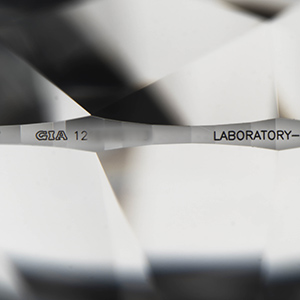
GIA’s grading lab recently detected “a number” of diamonds that had counterfeit GIA inscriptions on their girdles.
“This is not the first time we have seen this,” says spokesperson Stephen Morisseau. “But recently we have seen a number of stones with fake inscriptions.”
According to GIA, the diamonds were submitted for updated reports or verification services, but their qualities did not match the GIA reports associated with the inscriptions, which turned out to be counterfeit. The diamonds in question were either lab-grown or treated naturals; the reports connected to the fake inscriptions were for non-treated or natural diamonds.
In one example, a diamond was submitted with an inscription that indicated it was a 1.5 ct. natural diamond, E VVS2, type I, with an excellent cut grade. In actuality, the diamond was lab-grown, 1.51 cts., D VVS2, type IIa, with a very good cut grade.
“It [was] clear that these are two different diamonds,” the GIA said in a statement, even if “the weights and grading parameters of the original and newly submitted diamonds were close to each other.”
In these cases, the GIA overwrote the counterfeit inscription with an X, and inscribed the girdle with a new report number and, when applicable, the word laboratory-grown. It then issued a new, accurate report, noting the diamond’s treatment or non-natural origin.
So who is doing this? “Obviously, we know who submitted them,” says Morisseau. “But we are not making any statement about patterns, or types of stones, or [submission] locations.”
The statement added: “These instances of attempted fraud highlight why it is important, especially in any transaction where the buyer does not have a trusted relationship with the seller, to have the diamond grading report updated prior to completing a purchase.”
The statement noted that GIA’s client agreement gives it the option of notifying the “submitting client, law enforcement, and the public” about any instance of purported fraud. However, Morisseau says he cannot comment on how GIA is handling these instances.
It is a violation of the Federal Trade Commission’s Guides for the Jewelry Industry to pass off a lab-grown diamond as natural without clearly and conspicuously disclosing its origin.
Top: GIA’s correction of a diamond with a fake inscription (photo courtesy of GIA)
Follow JCK on Instagram: @jckmagazine
Follow JCK on Twitter: @jckmagazine
Follow JCK on Facebook: @jckmagazine





